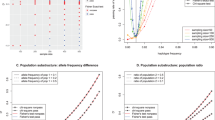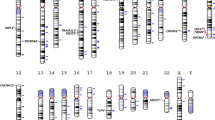Abstract
From its introduction into the literature, the idea of haplotype map-based linkage disequilibrium (LD) studies has been the subject of disputes. These queries involve the extent to which the haplotype blocks exist, the validity of fundamental concepts such as the recombination hotspot, and the application of this idea in the form of the HapMap project. In this article, we review the relevant literature to evaluate the potential importance of haplotype maps for psychiatric genetics. We first take a closer look at the nature of haplotype blocks and then address the impact of block definitions and methodological factors, such as single-nucleotide polymorphism density and sample size, on findings from haplotype block studies. After distinguishing between two types of haplotype map-based LD studies, we discuss the importance of the recombination hotspot and the nature of the disease mutations affecting complex traits. In the final section, we summarize our main conclusions and comment on the usefulness of haplotype maps for finding genes.
This is a preview of subscription content, access via your institution
Access options
Subscribe to this journal
Receive 12 print issues and online access
$259.00 per year
only $21.58 per issue
Buy this article
- Purchase on Springer Link
- Instant access to full article PDF
Prices may be subject to local taxes which are calculated during checkout




Similar content being viewed by others
References
Kruglyak L, Nickerson DA . Variation is the spice of life. Nat Genet 2001; 27: 234–236.
Weiss KM, Clark AG . Linkage disequilibrium and the mapping of complex human traits. Trends Genet 2002; 18: 19–24.
Boehnke M . A look at linkage disequilibrium. Nat Genet 2000; 25: 246–247.
Kruglyak L . Prospects for whole-genome linkage disequilibrium mapping of common disease genes. Nat Genet 1999; 22: 139–144.
Dunning AM, Durocher F, Healey CS, Teare MD, McBride SE, Carlomagno F . et al. The extent of linkage disequilibrium in four populations with distinct demographic histories. Am J Hum Genet 2000; 67: 1544–1554.
Jeffreys AJ, Kauppi L, Neumann R . Intensely punctate meiotic recombination in the class II region of the major histocompatibility complex. Nat Genet 2001; 29: 217–222.
Daly MJ, Rioux JD, Schaffner SF, Hudson TJ, Lander ES . High-resolution haplotype structure in the human genome. Nat Genet 2001; 29: 229–232.
Rioux JD, Daly MJ, Silverberg MS, Lindblad K, Steinhart H, Cohen Z . et al. Genetic variation in the 5q31 cytokine gene cluster confers susceptibility to Crohn disease. Nat Genet 2001; 29: 223–228.
Patil N, Berno AJ, Hinds DA, Barrett WA, Doshi JM, Hacker CR . et al. Blocks of limited haplotype diversity revealed by high-resolution scanning of human chromosome 21. Science 2001; 294: 1719–1723.
Johnson GC, Esposito L, Barratt BJ, Smith AN, Heward J, Di Genova G . et al. Haplotype tagging for the identification of common disease genes. Nat Genet 2001; 29: 233–237.
Gabriel SB, Schaffner SF, Nguyen H, Moore JM, Roy J, Blumenstiel B . et al. The structure of haplotype blocks in the human genome. Science 2002; 296: 2225–2229.
Dawson E, Abecasis GR, Bumpstead S, Chen Y, Hunt S, Beare DM . et al. A first-generation linkage disequilibrium map of human chromosome 22. Nature 2002; 418: 544–548.
Zhang K, Akey JM, Wang N, Xiong M, Chakraborty R, Jin L . Randomly distributed crossovers may generate block-like patterns of linkage disequilibrium: an act of genetic drift. Hum Genet 2003; 113: 51–59.
Phillips MS, Lawrence R, Sachidanandam R, Morris AP, Balding DJ, Donaldson MA . et al. Chromosome-wide distribution of haplotype blocks and the role of recombination hot spots. Nat Genet 2003; 33: 382–387.
Couzin J . Genomics. New mapping project splits the community. Science 2002; 296: 1391–1393.
Helmuth L . Genome research: map of the Human Genome 3.0. Science 2001; 293: 583b–585b.
Bamshad M, Wooding SP . Signatures of natural selection in the human genome. Nat Rev Genet 2003; 4: 99–111.
Lai E, Bowman C, Bansal A, Hughes A, Mosteller M, Roses AD . Medical applications of haplotype-based SNP maps: learning to walk before we run. Nat Genet 2002; 32: 353.
Templeton AR, Weiss KM, Nickerson DA, Boerwinkle E, Sing CF . Cladistic structure within the human lipoprotein lipase gene and its implications for phenotypic association studies. Genetics 2000; 156: 1259–1275.
Templeton A, Sing C . A cladistic analysis of phenotype associations with haplotypes inferred from restriction endonuclease mapping. IV. Nested analyses with cladogram uncertainty and recombination. Genetics 1993; 134: 659–669.
Maniatis N, Collins A, Xu CF, McCarthy LC, Hewett DR, Tapper W . et al. The first linkage disequilibrium LD maps: delineation of hot and cold blocks by diplotype analysis. Proc Natl Acad Sci USA 2002; 99: 2228–2233.
Zhang W, Collins A, Maniatis N, Tapper W, Morton NE . Properties of linkage disequilibrium LD maps. Proc Natl Acad Sci USA 2002; 99: 17004–17007.
Collins A, Ennis S, Taillon-Miller P, Kwok PY, Morton NE . Allelic association with SNPs: metrics, populations, and the linkage disequilibrium map. Hum Mutat 2001; 17: 255–262.
Wang N, Akey JM, Zhang K, Chakraborty R, Jin L . Distribution of recombination crossovers and the origin of haplotype blocks: the interplay of population history, recombination, and mutation. Am J Hum Genet 2002; 71: 1227–1234.
Slager SL, Huang J, Vieland VJ . Effect of allelic heterogeneity on the power of the transmission disequilibrium test. Genet Epidemiol 2000; 18: 143–156.
Cardon LR, Abecasis GR . Using haplotype blocks to map human complex trait loci. Trends Genet 2003; 19: 135–140.
Lewontin RC . On measures of gametic disequilibrium. Genetics 1988; 120: 849–852.
Ardlie KG, Kruglyak L, Seielstad M . Patterns of linkage disequilibrium in the human genome. Nat Rev Genet 2002; 3: 299–309.
Hudson RR . Properties of a neutral allele model with intragenic recombination. Theor Popul Biol 1983; 23: 183–201.
Kingman JF . Origins of the coalescent 1974–1982. Genetics 2000; 156: 1461–1463.
Rosenberg NA, Nordborg M . Genealogical trees, coalescent theory and the analysis of genetic polymorphisms. Nat Rev Genet 2002; 3: 380–390.
Templeton AR, Clark AG, Weiss KM, Nickerson DA, Boerwinkle E, Sing CF . Recombinational and mutational hotspots within the human lipoprotein lipase gene. Am J Hum Genet 2000; 66: 69–83.
Zhang K, Deng M, Chen T, Waterman MS, Sun F . A dynamic programming algorithm for haplotype block partitioning. Proc Natl Acad Sci USA 2002; 99: 7335–7339.
Meng Z, Zaykin D, Chun-Fang X, Wagner M, Ehm M . Selection of genetic markers for association analyses, using linkage disequilibrium and haplotypes. Am J Hum Genet 2003; 73: 115–130.
Nickerson DA, Taylor SL, Fullerton SM, Weiss KM, Clark AG, Stengard JH . et al. Sequence diversity and large-scale typing of SNPs in the human apolipoprotein E gene. Genome Res 2000; 10: 1532–1545.
Van den Oord EJCG, Sullivan PF, Walsh D, O'Neill A, Kendler KS, Riley BP . Identification of a high risk haplotype for the dystrobrevin binding protein 1 DTNBP1 gene in the Irish study of high density schizophrenia families. Mol Psychiatry 2003; 8: 499–510.
Tishkoff SA, Williams SM . Genetic analysis of African populations: human evolution and complex disease. Nat Rev Genet 2002; 3: 611–621.
de la Chapelle A, Wright FA . Linkage disequilibrium mapping in isolated populations: the example of Finland revisited. Proc Natl Acad Sci USA 1998; 95: 12416–12423.
Kauppi L, Sajantila A, Jeffreys AJ . Recombination hotspots rather than population history dominate linkage disequilibrium in the MHC class II region. Hum Mol Genet 2003; 12: 33–40.
Stumpf MP, Goldstein DB . Demography, recombination hotspot intensity, and the block structure of linkage disequilibrium. Curr Biol 2003; 13: 1–8.
Zhang K, Calabrese P, Nordborg M, Sun F . Haplotype block structure and its applications to association studies: power and study designs. Am J Hum Genet 2002; 71: 1386–1394.
Petes TD . Meiotic recombination hot spots and cold spots. Nat Rev Genet 2001; 2: 360–369.
Guillon H, de Massy B . An initiation site for meiotic crossing-over and gene conversion in the mouse. Nat Genet 2002; 32: 296–299.
Badge RM, Yardley J, Jeffreys AJ, Armour JA . Crossover breakpoint mapping identifies a subtelomeric hotspot for male meiotic recombination. Hum Mol Genet 2000; 9: 1239–1244.
Arnheim N, Calabrese P, Nordborg M . Hot and cold spots of recombination in the human genome: the reason we should find them and how this can be achieved. Am J Hum Genet 2003; 73: 5–16.
Pal C, Hurst LD . Evidence for co-evolution of gene order and recombination rate. Nat Genet 2003; 33: 392–395.
Cowles CR, Joel NH, Altshuler D, Lander ES . Detection of regulatory variation in mouse genes. Nat Genet 2002; 32: 432–437.
Chakravarti A . Population genetics—making sense out of sequence. Nat Genet 1999; 21: 56–60.
Lander ES . The new genomics: global views of biology. Science 1996; 274: 536–539.
Reich DE, Lander ES . On the allelic spectrum of human disease. Trends Genet 2001; 17: 502–510.
Hirschhorn JN, Lohmueller K, Byrne E, Hirschhorn K . A comprehensive review of genetic association studies. Genet Med 2002; 4: 45–61.
Lohmueller KE, Pearce CL, Pike M, Lander ES, Hirschhorn JN . Meta-analysis of genetic association studies supports a contribution of common variants to susceptibility to common disease. Nat Genet 2003; 33: 177–182.
Smith DJ, Lusis AJ . The allelic structure of common disease. Hum Mol Genet 2002; 11: 2455–2461.
Terwilliger JD, Weiss KM . Linkage disequilibrium mapping of complex disease: fantasy or reality? Curr Opin Biotechnol 1998; 9: 578–594.
Pritchard JK, Cox NJ . The allelic architecture of human disease genes: common disease-common variant…or not? Hum Mol Genet 2002; 11: 2417–2423.
Zwick M, Cutler D, Lin S, Chakravarti A . An empirical estimate of the number of SNPs required for a whole genome association study. Am J Hum Genet 2002; 71: 219, (abstract 278).
Van den Oord EJCG, Sullivan PF . A framework for controlling false discovery rates and minimizing the amount of genotyping in gene-finding studies. Hum Hered 2003 (in press).
Van den Oord EJCG, Sullivan PF . False discoveries and models for gene discovery. Trend Genet 2003; 19: 537–542.
Sham P, Bader JS, Craig I, O'Donovan M, Owen M . DNA pooling: a tool for large-scale association studies. Nat Rev Genet 2002; 3: 862–871.
Acknowledgements
EvdO was supported in part by grants from the US National Institute of Mental Health (MH065320) and NARSAD.
Author information
Authors and Affiliations
Corresponding author
Rights and permissions
About this article
Cite this article
van den Oord, E., Neale, B. Will haplotype maps be useful for finding genes?. Mol Psychiatry 9, 227–236 (2004). https://doi.org/10.1038/sj.mp.4001449
Received:
Revised:
Accepted:
Published:
Issue Date:
DOI: https://doi.org/10.1038/sj.mp.4001449
Keywords
This article is cited by
-
Genetic Variation in the α7 Nicotinic Acetylcholine Receptor is Associated with Delusional Symptoms in Alzheimer’s Disease
NeuroMolecular Medicine (2008)
-
No association between the genetic polymorphisms in the RTN4R gene and schizophrenia in the Chinese population
Journal of Neural Transmission (2007)
-
Positive Association of the Serotonin 5-HT7 Receptor Gene with Schizophrenia in a Japanese Population
Neuropsychopharmacology (2006)
-
Linkage disequilibrium and haplotype blocks in the MHC vary in an HLA haplotype specific manner assessed mainly by DRB1*03 and DRB1*04 haplotypes
Genes & Immunity (2006)
-
Will investments in biobanks, prospective cohorts, and markers of common patterns of variation benefit other populations for drug response and disease susceptibility gene discovery?
The Pharmacogenomics Journal (2005)



